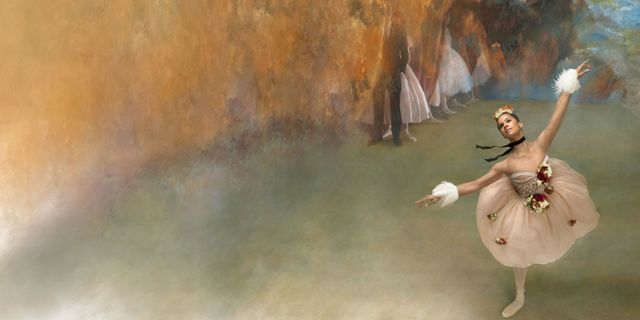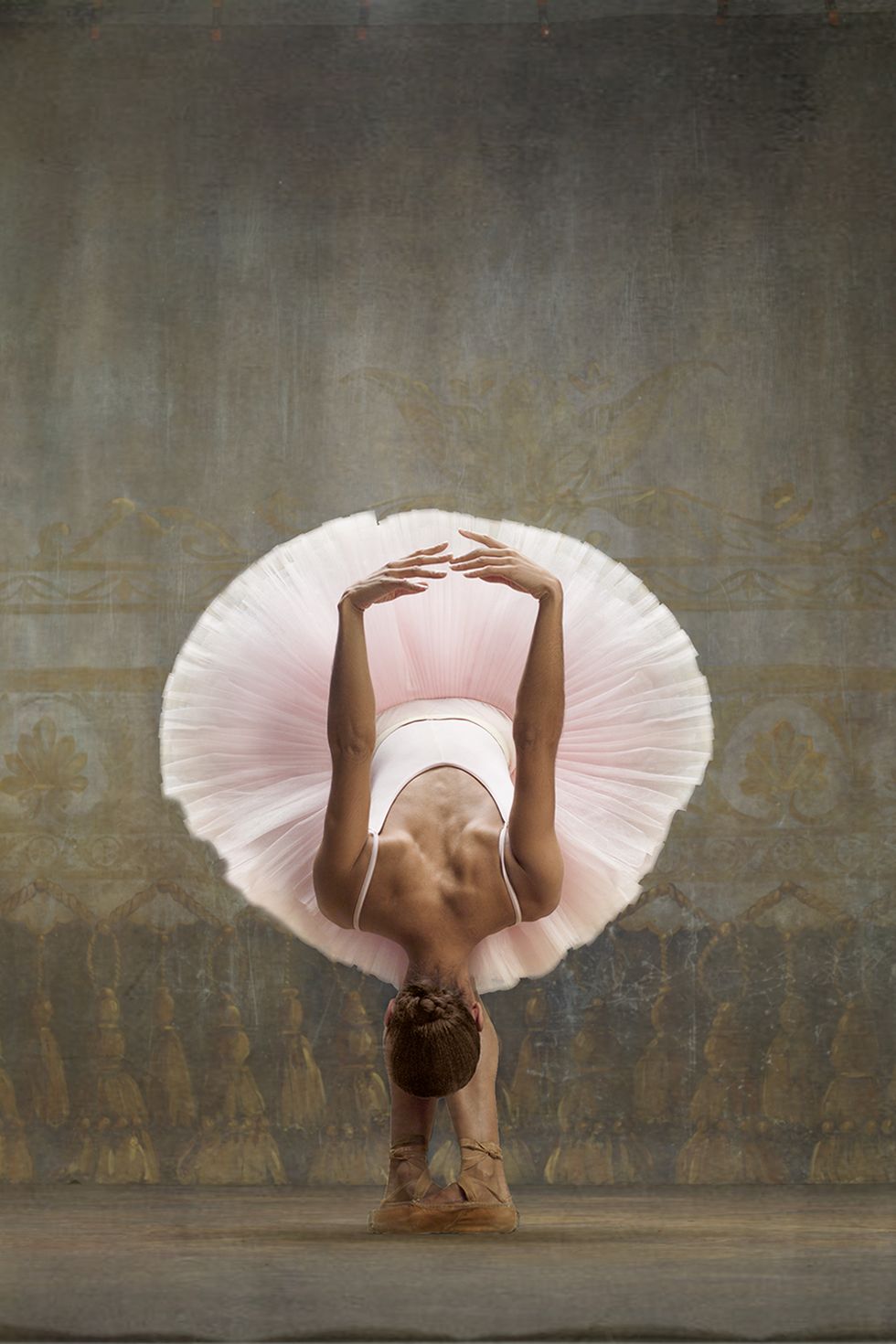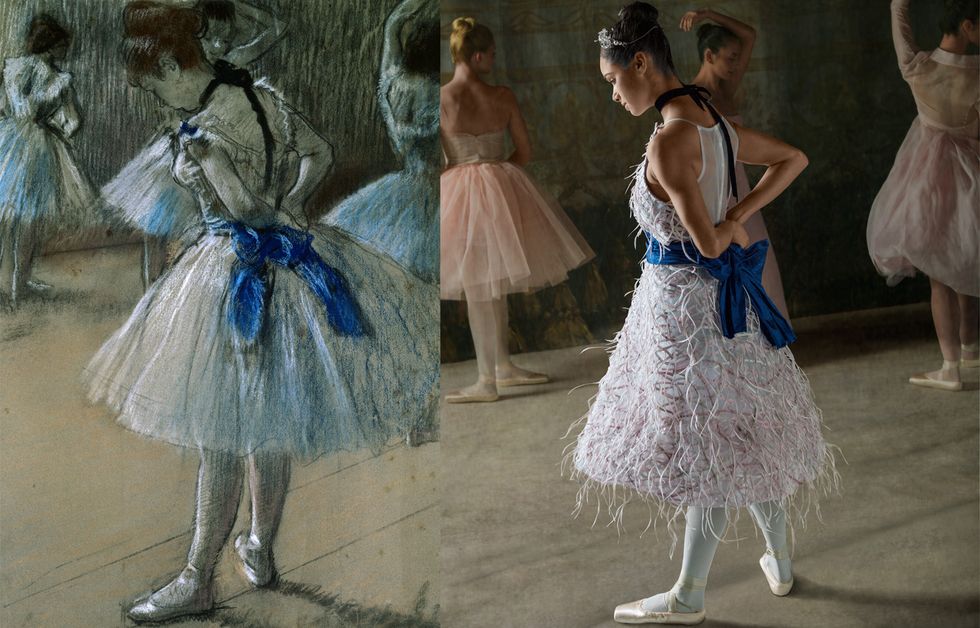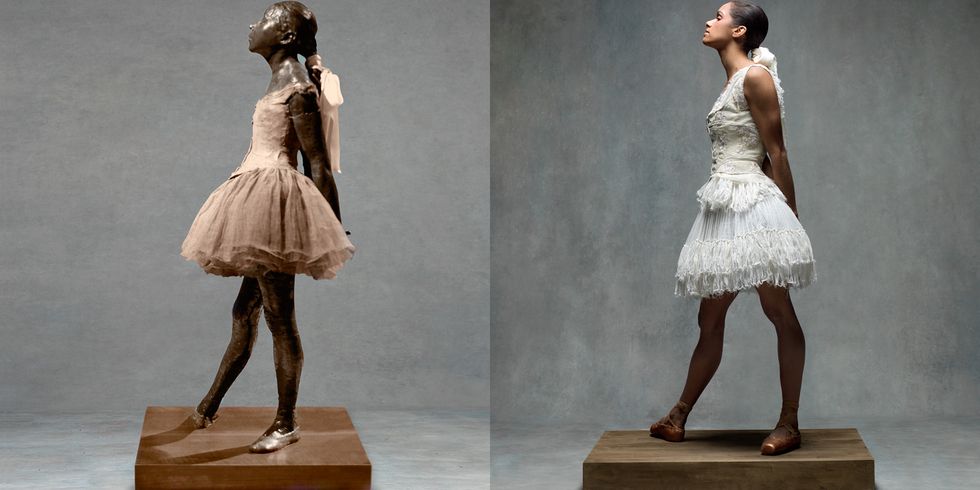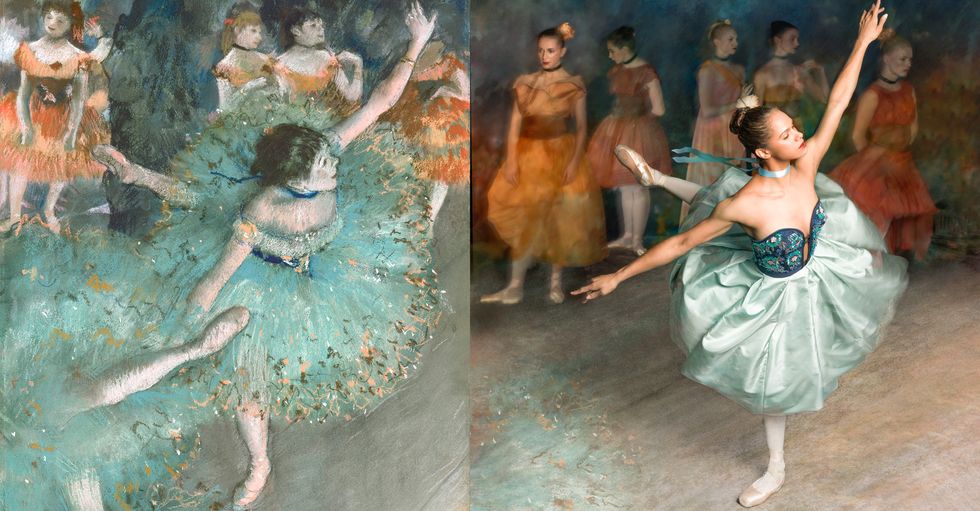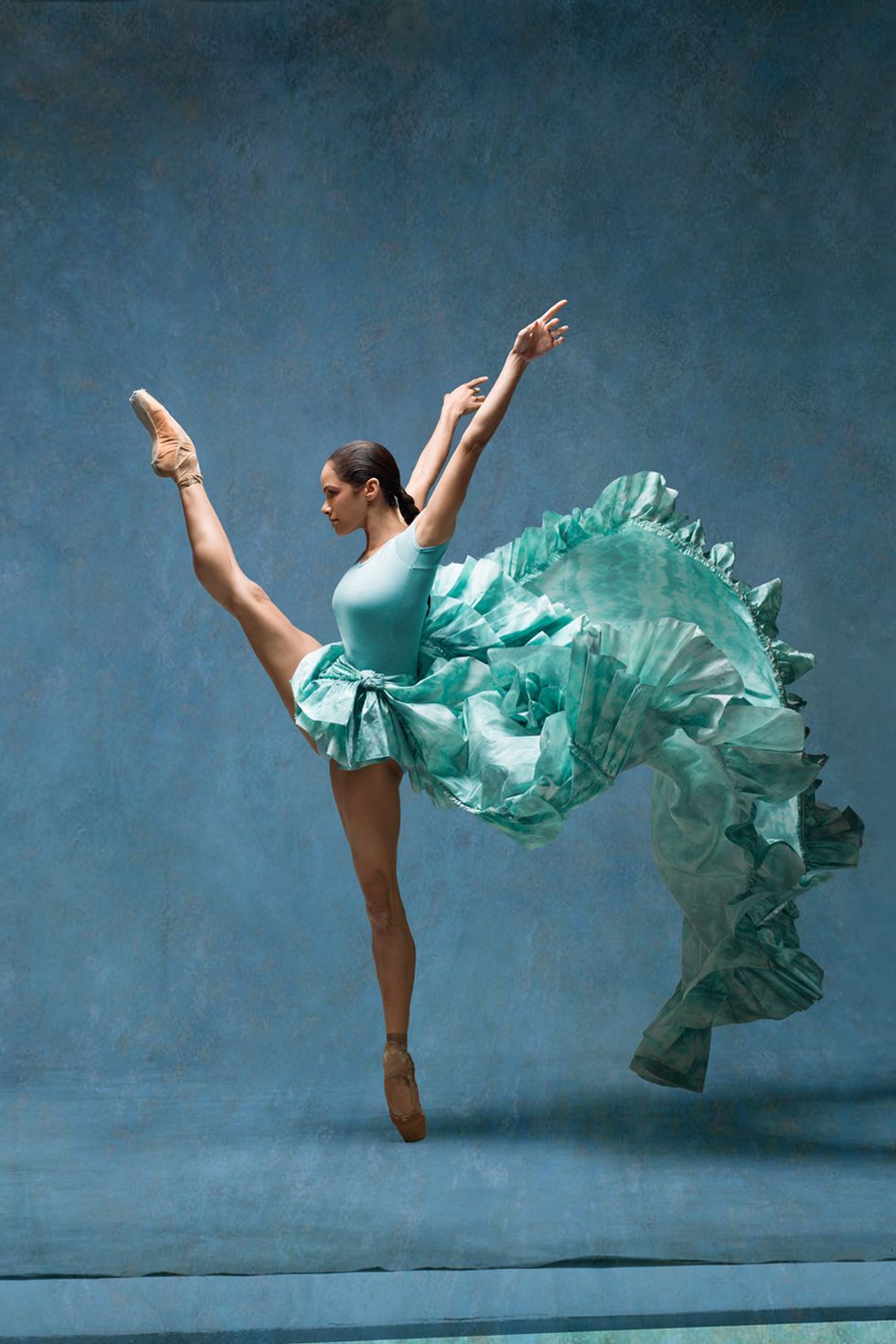Ballet dancers, Misty Copeland tells me, like to be in control. It's something about ballet itself—the painstaking quest to achieve the appearance of a kind of effortless athleticism, fluidity, and grace—that makes it hard to let go. "I think all dancers are control freaks a bit," she explains. "We just want to be in control of ourselves and our bodies. That's just what the ballet structure, I think, kind of puts inside of you. If I'm put in a situation where I am not really sure what's going to happen, it can be overwhelming. I get a bit anxious."
Copeland re-creates Degas's The Star; Valentino dress, $15,500, 212-355-5811; Wilhelm headpiece, $495, and corsages,$135, wilhelm-nyc.com; Mokuba ribbon, $11 per yard, 212-869-8900.
Copeland says that's part of the reason she found posing for the images that accompany this story—which were inspired by Edgar Degas's paintings and sculptures of dancers at the Paris Opéra Ballet—a challenge. "It was interesting to be on a shoot and to not have the freedom to just create like I normally do with my body," she says. "Trying to re-create what Degas did was really difficult. It was amazing just to notice all of the small details but also how he still allows you to feel like there's movement. That's what I think is so beautiful and difficult about dance too. You're trying to strive for this perfection, but you still want people to get that illusion that your line never ends and that you never stop moving."
Mirella leotard, $22, mirella-dance.com; Claudia Folts for Tutu.com tutu, $240, tutu.com.
It should probably come as no surprise that Copeland would have trouble conforming to someone else's idea of what a ballerina should look like; she gave that up a long time ago. At 33, she's in the midst of the most illuminating pas de deux with pop culture for a classical dancer since Mikhail Baryshnikov went toe-to-toe with Gregory Hines in White Nights. Last June, she was named a principal dancer at American Ballet Theatre, the first African-American woman to hold that distinction. She was also the subject of a documentary, Nelson George's A Ballerina's Tale, which chronicled her triumph over depression and body-image issues, as well as her comeback from a career-threatening leg injury in 2012. The story of her rise from living in a single room in a welfare motel with her mother and five siblings to the uppermost reaches of the dance world has become a sort of 21st-century parable: the unlikely ballerina, as Copeland referred to herself in the subtitle of her 2014 memoir, Life in Motion, who may be on her way to becoming the quintessential ballerina of her time.
Degas's ballet works, which the artist began creating in the 1860s and continued making until the years before his death, in 1917, were infused with a very modern sensibility. Instead of idealized vis -ions of delicate creatures pirouetting onstage, he offered images of young girls congregating, practicing, laboring, dancing, training, and hanging around studios and the backstage areas of the theater. Occasionally, portly men or dark figures appear, directing or otherwise coloring the proceedings. "People call me the painter of dancing girls," Degas is said to have once told his Paris art dealer Ambroise Vollard, the Larry Gagosian of the day. "It has never occurred to them that my chief interest in dancers lies in rendering movement and painting pretty clothes." It's an unsentimental place, Degas's ballet, and his representation of the dancers is far from sympathetic. But it's a space where he discovered not only a freedom for himself as an artist but also a kind of beauty that existed behind all the beauty of the performance and in the struggle of his subjects to become something.
Copeland as Degas's Dancer; Carolina Herrera top, $1,490, skirt, $4,990, 212-249-6552; Hatmaker by Jonathan Howard headpiece, $750, hatmaker.com.au; Mokuba ribbon, $11 per yard, 212-869-8900; Mood Fabrics fabric (worn as a belt), 212-230-5003.
"Degas's focus on dance is part of his engagement with depicting the subjects, spaces, rhythms, and sensations of modern life," says Jodi Hauptman, senior curator in the department of drawings and prints at New York's Museum of Modern Art, where an exhibition that explores Degas's extensive work in monotype, "Edgar Degas: A Strange New Beauty," opens this month. "His vision wanders and focuses, taking note of what usually is overlooked and homing in on what best reflects the conditions of his time."
In her own way, Copeland is now forcing people to look at ballet through a more contemporary lens. "I see a great affinity between Degas's dancers and Misty," says Thelma Golden, director and chief curator of the Studio Museum in Harlem. "She has knocked aside a long-standing music-box stereotype of the ballerina and replaced it with a thoroughly modern, multicultural image of presence and power," Golden says. "Misty reminds us that even the greatest artists are humans living real lives."
The first blush with ballet for Copeland was famously unromantic. Her mother, Sylvia DelaCerna, was a cheerleader for the Kansas City Chiefs, and her older sister had been a member of the drill team at their middle school in Hawthorne, near their home in San Pedro, California. So, at the age of 13, Copeland decided to try out for the drill squad herself, choreographing her own routine—to George Michael's "I Want Your Sex." "An odd choice of song," she says. "I chose 'I Want Your Sex' not really knowing anything about what that meant. But that's how my whole dance career took off."
Copeland as Degas's Little Dancer Aged Fourteen; Alexander McQueen dress, $4,655, and corset, $4,525, 212-645-1797; Mood Fabrics ribbon (in hair), 212-230-5003.
Copeland didn't just make the team; she was named captain. Her drill coach, Elizabeth Cantine, had a background in classical dance and suggested that Copeland try taking a ballet class at the local Boys & Girls Club. "The class was given on a basketball court, and I was wearing my gym clothes and socks—pretty far from a Degas painting," Copeland recalls. But she was hooked. Within three months, she was dancing en pointe. "Before dance came into my life, I don't really remember having any major goals or dreams of wanting to be anything. In the environment I grew up in, we were constantly in survival mode," Copeland says. "I went to school, and I was really just trying to fit in and not be seen. But ballet was this thing that just felt so innate in me, like I was meant to be doing this."
Kevin McKenzie, the longtime artistic director of ABT, has said that it's Copeland's visceral response to music, combined with her unique proportions and exceptional coordination, that makes her a special dancer. What makes her a star, though, is something else. If Copeland isn't yet an icon, then she is the embodiment of a set of images and experiences that might seem foreign to the world of ballet, were they not so eerily familiar to so many ballet dancers. It's a job that involves spending a lot of time toiling in dusty studios in front of mirrors that constantly remind you of who you are and what you look like. Copeland has been staring into those determined eyes of hers much, much longer than we have; she knows just how hard it was to get to the point where they started to look back with anything resembling approval.
Copeland as Swaying Dancer (Dancer in Green); Oscar de la Renta dress, $5,490, 212-288-5810; Mokuba ribbon, $11 per yard; Hatmaker by Jonathan Howard headpiece corsage, $70, hatmaker.com.au.
"I was drawn to ballet and performing for a reason that I think a lot of people can't really understand or relate to," she says. "People think it's like, 'You're out there,' or 'You're exposed.' But I felt safe when I was on the stage, like no one could get to me. It was the first time in my life that I felt protected," Copeland continues. "So when all of the media and the attention that came along with me entering the ballet world arrived, that was not what I wanted. I take it all very lightly, in terms of people calling me a 'celebrity' and things like that. I think what I'm doing is showing people how incredible the arts can be for a child and how it's changed my life. I try not to get caught up in the other stuff, but I understand the importance of me doing it."
Alberta Ferretti dress, $2,8090, 310-652-9000.
Copeland is engaged to Olu Evans, an attorney, who she's been with for more than a decade. They live together in an apartment on Manhattan's Upper West Side. She admits to an "intensifying" designer-footwear addiction, and while she's still working out the details of her nuptials, she confesses giddily that Christian Louboutin is making her shoes for the occasion. Most days, though, she dances, and when she's not training she's working to maintain herself physically so she can continue to perform at a high level as she gets older. "I'm a bit of a loner," Copeland says. "If I don't have to be around a lot of people, I don't like to. I have a really small circle of friends. I just love cooking and relaxing."
Nevertheless, she has at least begun to entertain notions of what lies beyond her dancing life. "It's hard to even think about those things being in the midst of my career right now," she says. "I know I'll be a part of the dance world, probably write some more books. But I also cherish family so much. I think, growing up, before ballet became my safe haven, my siblings and I were like this little village. We were together, and we looked out for each other. So that just makes me want to value the little family I create one day even more."
Dancing with the star. Capezio leotard, $30, capezio.com; Roberto Cavalli skirt, price upon request, 212-755-7722.
One of Degas's best-known ballet works is Little Dancer Aged Fourteen, a sculpture of a young ballerina lost in a moment of her own. "I definitely feel like I can see myself in that sculpture—she just seems content but also reserved," Copeland says. "I was really shy and introverted at that age. I don't even have an image in my head of what I remember a ballerina being or existing before I took a ballet class. Ballet was just the one thing that brought me to life."
See a behind-the-scenes look at the photoshoot below:
Video shot by Sandy Chase. Photography by Ken Browar and Deborah Ory of the NYC Dance Project. To learn more visit: nycdanceproject.com.
